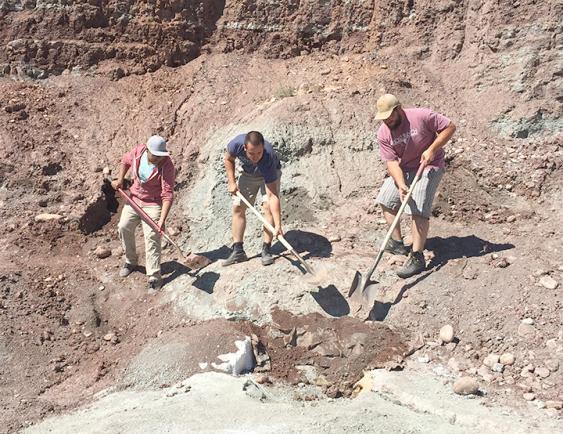Expedition ends—Oswego undergraduates (from left) Jake Ganpat, Rob Katz and Nick Myers complete their three weeks of excavation in New Mexico’s Hayden Quarry under the mentorship of Dr. Jennifer Olori of biological sciences, who won a $19,771 grant for the trip from the National Geographic Society.
Thanks to a National Geographic Society Committee for Research and Exploration grant, three SUNY Oswego undergraduates spent three weeks at Ghost Ranch, New Mexico, this summer unearthing such fossils as the tiny jaws of ancient animals—and the fossilized bones of a rare dinosaur—as they tried on paleontology careers.
The society’s support of their mentor, Dr. Jennifer Olori of the biological sciences department, provided $19,771 to enable students Jake Ganpat, Rob Katz and Nick Myers to accompany Olori to Hayden Quarry, a fertile site for piecing together the origins of dinosaurs as well as much smaller animals.

The team—along with fellow researchers from SUNY Stony Brook and other universities and museums—was in search of fossils and fragments from 212 million years ago during the Late Triassic Period. The microvertebrate scales and bones they found belonged to fish, reptiles and small four-legged animals.
“We went being very mindful of the small stuff this time,” said Olori, a Hayden Quarry veteran who joined the SUNY Oswego faculty in 2011 and has often mentored undergraduates in best practices for scientific research. “(For example,) we found three really tiny, slender jaws. We can usually tell what type of animal jaws come from, but not these. These were so small.” She said the Natural History Museum of Utah will use CT scanning to help the Oswego team identify them.
Working alongside researchers from around the nation, the Oswego team had the opportunity to help with a larger find: They assisted paleobiological researcher Dr. Sarah Werning of Des Moines University in exposing the femur of a relatively small, carnivorous dinosaur called Tawa hallae, first described in 2009 following a series of finds in Hayden Quarry. The team then unearthed more bones in a grouping thought to be from a single specimen, Olori said.
Fieldwork skills
“It’s really awesome when you find an actual large bone,” said Ganpat, who aims to attend graduate school to study paleontology. “I found another full femur about the size of a banana. We plaster-casted it, but we don’t know what (animal) it is yet.”
Olori said such experiences are invaluable for undergraduates. “This trip was really inspiring for us,” she said. “To be part of every step in the process is something I think is really exciting. It helps bring real research into what we teach.”
Microvertebrate specimens have to be collected and prepared in “a really different way. That’s a special skillset, and not a lot of people do that,” Olori said.
One of the first steps was for the students to build screen-washing boxes to filter dirt and other particles from fossils and shards. Then came the hard work of prospecting, excavating, screen washing—it sometimes takes tons of material to get the complete picture of a dig—casting, cataloguing, protecting and transporting. This semester, students likely will start working with Olori on analysis and writing for one or more scholarly papers based on the team’s work this summer.
“I think any time you have students practicing hands-on work in the field, you learn skills in paleontology, certainly, but you also learn the history and evolution of animals whose remains we encountered,” Olori said.
Katz, a Cooperstown native who graduated in August and now works with fossils in a commercial quarry in Wyoming, said he has been interested in paleontology “literally my entire life.”
Making his second trip with Olori to Hayden Quarry this summer, Katz said, “It’s a unique community. You can’t get more involved in paleontology. More than anything, it’s an opportunity to speak and work with professionals in the field, to find out what kinds of careers are available and to get more involved.”
For more information on opportunities in the biological sciences at SUNY Oswego, visit oswego.edu/biology.
PHOTO CAPTION: Field experience—SUNY Oswego senior zoology major Jake Ganpat (center) works this summer with Dr. Sarah Werning, a Des Moines University assistant professor, to expose fossils that proved to be from a relatively small dinosaur called Tawa hallae in Hayden Quarry near Ghost Ranch, New Mexico. Ganpat and two other undergraduates accompanied Oswego biological sciences faculty member Dr. Jennifer Olori there for three weeks, thanks to a National Geographic Society grant.




